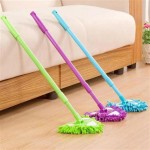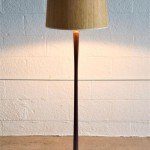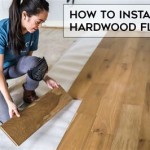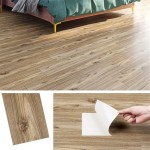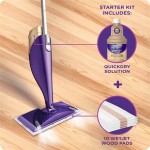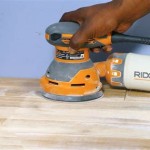How To Shine Engineered Wood Floors
Engineered wood flooring offers a beautiful and durable alternative to solid hardwood. Its construction, comprising layers of wood veneer adhered to a core board, provides enhanced stability and resistance to moisture compared to solid wood. However, like any flooring surface, engineered wood requires regular maintenance to retain its luster and prevent wear and tear. Shining engineered wood floors involves a combination of cleaning, protecting, and, in some cases, refinishing. The specific steps and products required depend on the floor’s finish and condition. Neglecting proper care can lead to dullness, scratches, and even permanent damage.
The initial step in achieving a shine on engineered wood is understanding the type of finish applied to the floor. Most commonly, engineered wood floors are finished with polyurethane, a durable and protective coating. Polyurethane finishes come in various sheens, ranging from matte to high-gloss. The existing sheen will influence the type of cleaning and polishing products that can be safely used. Other, less common finishes include oil-based treatments and lacquer. Identifying the finish is crucial because using an incompatible cleaning agent can damage the surface and strip away the protective layer.
Before undertaking any shining or polishing procedure, a thorough cleaning is essential. This removes dirt, dust, and debris that can scratch the floor during the polishing process. Regular cleaning also prevents the buildup of grime, which can dull the floor’s appearance over time.
Regular Cleaning and Maintenance
Regular cleaning is the cornerstone of maintaining the shine of engineered wood floors. A consistent cleaning routine prevents the accumulation of dirt and grime that can diminish the floor's luster. The frequency of cleaning depends on the amount of foot traffic and the presence of pets or children. High-traffic areas require more frequent cleaning than less-used rooms.
The preferred method for everyday cleaning is sweeping or vacuuming. A soft-bristled broom or a vacuum cleaner with a floor brush attachment is recommended. Avoid using vacuums with beater bars, as these can scratch the floor's surface. Sweeping or vacuuming should be performed at least once a week, or more frequently in high-traffic areas. This removes loose dirt, dust, and debris that can abrade the finish over time.
For more thorough cleaning, damp mopping is the next step. However, it is crucial to use a minimal amount of water. Engineered wood is susceptible to water damage, and excessive moisture can cause warping, swelling, or discoloration. Always wring out the mop thoroughly before applying it to the floor. The mop should be damp, not wet.
Use a pH-neutral cleaner specifically designed for engineered wood floors. Avoid using general-purpose cleaners, bleach, ammonia, or abrasive cleaning agents. These products can damage the finish and dull the floor's shine. Follow the manufacturer's instructions for dilution and application. Apply the cleaning solution sparingly, and work in small sections. Rinse the mop frequently to prevent spreading dirt and grime. After mopping, allow the floor to air dry completely. Do not walk on the floor until it is dry to prevent water spots or streaks.
For spot cleaning, address spills immediately. Use a soft cloth or paper towel to blot up the spill. Avoid rubbing, as this can spread the stain. If the spill is sticky or greasy, use a damp cloth with a mild cleaner to remove the residue. Dry the area thoroughly after cleaning.
Placing mats at entrances helps to trap dirt and moisture, preventing them from being tracked onto the engineered wood floors. This reduces the need for frequent cleaning and protects the floor from abrasion. Regularly clean or replace these mats to maintain their effectiveness.
Polishing Engineered Wood Floors
Polishing engineered wood floors is an optional step that can enhance their shine and provide an extra layer of protection. However, polishing should not be performed too frequently, as it can lead to a buildup of polish residue. The frequency of polishing depends on the floor's condition and the desired level of shine.
Before polishing, ensure the floor is thoroughly clean and dry. Any dirt or debris left on the floor can be ground into the finish during polishing, causing scratches. Use a pH-neutral cleaner specifically designed for engineered wood floors to remove any remaining dirt or grime.
Select a polish that is specifically formulated for engineered wood floors with a polyurethane finish. Avoid using polishes that are designed for other types of flooring, such as tile or laminate. These polishes may contain ingredients that can damage the finish on engineered wood floors. The polish should be compatible with the floor's existing sheen. If the floor has a matte finish, use a matte polish. If the floor has a glossy finish, use a glossy polish. Using the wrong type of polish can result in an uneven or undesirable sheen.
Apply the polish according to the manufacturer's instructions. Typically, this involves applying a thin, even coat of polish to the floor using a microfiber mop or applicator pad. Work in small sections, and avoid applying too much polish. Over-application can result in a sticky or cloudy finish.
Allow the polish to dry completely before walking on the floor. The drying time varies depending on the type of polish and the humidity level. Typically, it takes several hours for the polish to dry completely. Follow the manufacturer's recommendations for drying time.
After the polish has dried, buff the floor with a clean, dry microfiber mop or cloth. Buffing helps to remove any streaks or haze and enhances the shine. Use a gentle, circular motion to buff the floor. Avoid applying too much pressure, as this can scratch the finish.
Avoid using paste waxes on engineered wood floors with a polyurethane finish. Paste waxes can create a cloudy buildup and make it difficult to recoat the floor in the future. If the floor has been previously waxed, it may be necessary to remove the wax before applying a polish. Consult with a flooring professional for advice on wax removal.
Addressing Scratches and Damage
Despite regular cleaning and polishing, engineered wood floors can still be susceptible to scratches and damage. Scratches can occur from furniture, pets, or dropped objects. Minor scratches can often be repaired with a scratch repair kit. Deeper scratches or damage may require professional refinishing.
Preventing scratches is the best approach. Use felt pads under furniture legs to protect the floor from scratches when moving furniture. Avoid wearing shoes with high heels or cleats on the floor. Trim pets' nails regularly to prevent scratches. Place rugs in high-traffic areas to protect the floor from wear and tear.
For minor scratches, a scratch repair kit can be used. These kits typically contain a variety of colored waxes or markers that can be used to fill in the scratches. Select a color that closely matches the floor's finish. Clean the area around the scratch with a damp cloth. Apply the wax or marker to the scratch, following the manufacturer's instructions. Wipe away any excess wax or marker with a clean cloth. Buff the area gently to blend the repair with the surrounding finish.
For deeper scratches or damage, professional refinishing may be necessary. Refinishing involves sanding down the existing finish and applying a new coat of finish. This can restore the floor to its original condition and remove any scratches or damage. However, it's important to remember that engineered wood floors have a limited wear layer, which is the thickness of the top veneer. Over-sanding can damage the core board and shorten the life of the floor. Therefore, refinishing should be performed by a qualified flooring professional who understands the limitations of engineered wood flooring.
In some cases, it may be possible to repair localized damage without refinishing the entire floor. A flooring professional can assess the damage and determine if a spot repair is feasible. Spot repairs involve sanding down the damaged area and applying a new coat of finish to match the surrounding floor. This can be a more cost-effective option than refinishing the entire floor.
Maintaining the shine of engineered wood floors requires a consistent and careful approach. Regular cleaning, appropriate polishing, and prompt attention to scratches and damage will help to keep the floor looking its best for years to come. By understanding the specific needs of engineered wood flooring and following the recommended maintenance procedures, one can preserve its beauty and extend its lifespan.

How To Clean Engineered Wood Floors Expert Tips

Engineered Wood Floors Cleaning And Polishing Kiwi Services

Tips On How To Maintain Engineered Hardwood Floors Twenty Oak

Restoring Engineered Hardwood Floors Full Of Residue Recoating With Semi Gloss Finish

How To Clean Engineered Hardwood Floors Tips Techniques

How To Clean Engineered Hardwood Floors Carlisle Wide Plank

Top Tips How To Clean Engineered Wood Flooring Munster Hardwood

How To Take Care Of Engineered Wood Flooring Jgflooring

How To Clean Engineered Wood Floors Dos And Don Ts Teka Flooring

Restoring Engineered Hardwood Floors To A Gloss Sheen With Color Correction Wood Floor Refinishing Youtube
